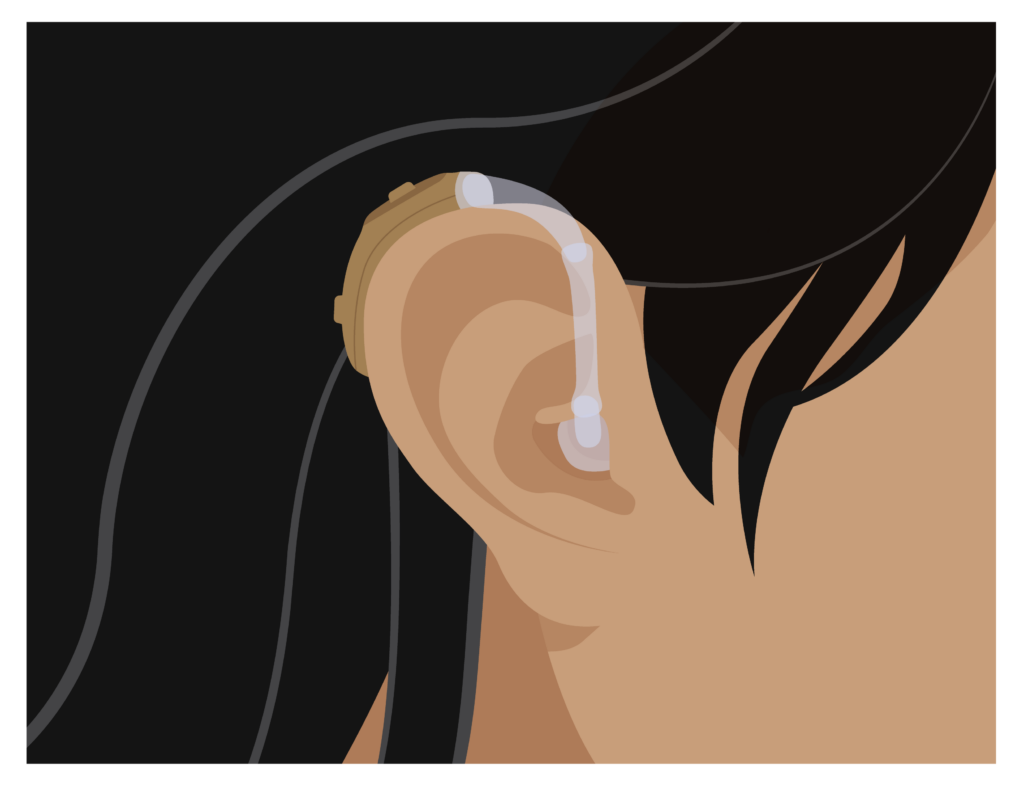After hearing aid programming, it is important to carry out a hearing aid trial.
Prepare the child by explaining that using hearing aids is not the same as having normal hearing. It takes time to adjust to using hearing aids.
A hearing aid trial allows the hearing aids to be adjusted for their comfort.
A hearing aid trial includes:
- Fitting the hearing aids
- Adjusting the hearing aids.
Instruction
The steps for fitting a hearing aid are the same for adults and children.
Remind yourself by watching this video of fitting a hearing aid.
For more information on fitting hearing aids refer to the TAP Preprogrammed hearing aids module.
Fit hearing aids
Remove the batteries before fitting the hearing aid.
- Select a suitable size of earmould
- Mark the earmould tube and remove hearing aid.
Tip
Young children usually need a small earmould. Always check the earmould fit.
Let the child touch the earpiece before putting it in their ear to reassure them it will not hurt.
- Cut the earmould tube to the correct length.
Warning
Never use scissors near the child. Always remove the hearing aid before cutting the earmould tube.
Check fit of hearing aid
Check the hearing aid rests comfortably on top of the child’s ear.

Question
How do you check the earmould fits correctly?
Select two.
If you selected a and d, you are correct!
The earmould should be comfortable in the ear canal with no gaps. It should be easy to insert and remove.
Adjust hearing aids
Make adjustments to the hearing aids if needed.
Tip
To avoid giving the child a shock, make sure the volume is turned down completely before switching on the hearing aid. Increase the sound gradually to a comfortable level before the Ling sounds test.
Prepare:
- Insert the battery, leaving the door half open
- Insert the earmould into the child’s ear and put a hearing aid on each ear.
Check child can hear your voice clearly
The Ling sounds test is used by a health worker or caregiver.
It is used to test if a child can hear well with hearing aids. The sounds used represent speech sound across low, middle and high frequencies.
If a child responds to all six Ling sounds, it shows they can hear the sounds of speech at normal conversation levels.
Instruction
Listen to and watch the six Ling sounds.
Activity
Play the recording again. Pause after each sound and practice.
Ling sound testing
Ling sounds testing is done with the child wearing their hearing aids. The test should be done in a quiet room to avoid background noise.

Prepare
Make sure that the child’s hearing aids are on and at the correct setting.
If the child is doing the test for the first time, explain the test and practice to check they understand.
Test
Sit at eye level, one and a half metres away from the child. Ask the child to listen. It is important that the child cannot see your mouth.
- Hold a piece of card 10 centimetres away from your mouth
- Speak in a normal speaking voice and say the sounds one at a time:
- Wait for the child to respond after each sound
- The child should repeat each sound back to you to confirm they can hear the sound clearly.
To pass the test, a child should hear at least five out of six of the sounds.
Tip
If the child is not able to repeat the Ling sounds verbally, they can identify the sound by pointing to the correct picture on a pointing card.

Tip
While testing:
- Say all six Ling sounds at least three times in random order to avoid the child learning a pattern
- Vary the length of pauses
- Occasionally do not say any sound. Encourage the child to say if they do not hear anything.
Activity
In pairs, one person is the tester, and the other person is being tested.
- Tester: Use a card to cover your mouth and have a list of the six Ling sounds.
- Person being tested: Hold a card with Ling sounds and pictures.
You should both sit on chairs one and a half metres apart.
- Tester: In a normal speaking voice say the first Ling sound.
- Person being tested: Repeat the sound back to the tester.
Continue until all sounds have been tested. Take turns to be tester and person being tested.
Check for feedback
Put your open hand 5-10 centimetres away from the hearing aid on the child’s ear. There should be no feedback (whistling) sound.

Instruction
Check the problem solving table for solutions if there is feedback.
Discuss adjustments to the hearing aid settings with your mentor if these actions do not solve the problem.
Check how the hearing aid sounds
Ask the child and/or caregiver questions to understand if the child is comfortable with how their hearing aid sounds.
Ask questions such as:
- How does that sound?
- Are you comfortable with the sound level?
Ask about the sound level for each hearing aid.
If the child and their caregiver are not satisfied with the trial, discuss with your mentor. Refer to an ear and hearing professional if needed.